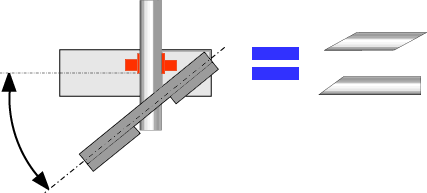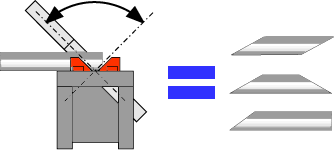The obvious reason is to cut angles, but it goes much further than that. Below we have listed some of the arguments for buying a vertical saw rather than a horizontal.
![]()
| Vertical saws provide more consistent cutting (feed) pressures throughout the cut, which leads to longer blade life. With a horizontal bandsaw one faces the problem of changing forces of gravity as the saw descends into the cut. The saw wants to fall faster the closer to horizontal it gets, causing variance in feed pressures. All manufacturers of hinge type horizontal bandsaws face this problem. All must deal with this situation, but not all deal with it in an effective manner. Vertical saws stand upright and because of their design do not encounter the aforementioned problem, resulting in more consistent feed pressures, longer blade life due to the constant pressures, and straighter cuts. |
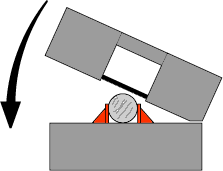
With horizontal saws the feed force increases as the frame descends. |
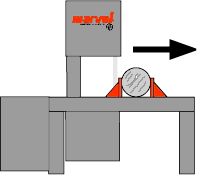
Vertical saws produce consistent feed pressure. |
| Manual
measurement of material is easier on a vertical saw. If the machine
is non-automatic: most, if not all cut off pieces will be manually measured.
It is easier to manually measure from the blade on a vertical than a horizontal.
On a vertical saw the stationary vise jaws will be the rear jaws, which
are close to the blade. When measuring from the blade on a horizontal,
the blade has to be positioned down next to the material, requiring additional
time. Also, with the horizontal cutting, there is always the risk
of running the blade too far down and into the material, destroying the
teeth.
|
| Verical tilt frame saws make cutting miters fast and easy while allowing for straight line feeding of the material. There are two different configurations of horizontal angle cutting saws. The most common is a design where the vise jaws swivel to cut angles. This is the least expensive design but causes the operator to swivel the material as well. If the piece you are working with is long, the support tables also need to be moved. This requires additional set up time and floor space. With a vertical tilt frame, the material is always in the same line and the saw frame pivots to accommodate for the angle. |
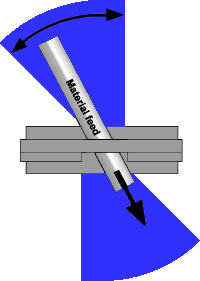
Horizontal saw - top view. Material must be moved to match angle of vise. Material handling area increases dramatically. |
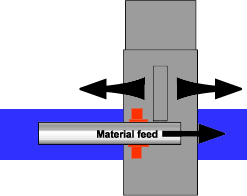
Vertical saw - top view. Column tilts up to 45º left and right. Material always feeds in a straight line. Material handling area remains constant.
|
| The design of the vertical tilt frame saw provides for ease of loading material on the machine's work table. With a vertical tilt frame machine the saw frame retracts back behind the table when not cutting which makes it easier to load the machine with either an overhead crane or forklift. On a horizontal saw the material has to be placed on a support table and then run into the machine and under the blade. There is always the risk of the saw frame not being high enough to clear the work piece or the moveable guide not being open wide enough. In either case, the blade or the guide arm could be damaged. The table being clean and open on a vertical allows the material to be dropped into place without additional material handling being required. |
Vertical
saws allow for cutting both directions from 90º and provide for more
versatality and less material handling. The nature of the vertical
tilt frame design makes it much easier to cut trapezoid angles because
most tilt frame verticals tilt both directions. If one was to cut
this same type angle on a horizontal swivel head saw one would have to
remove the piece from the machine and turn it around. Depending
on the size of the material being cut, this could be a material handling
problem, but in any case will take more time.
|
| Operation
of the machine is easier with a vertical saw. Generally the controls
are located directly on the front of the machine right in line with the
blade. With the controls located in front on the machine, in line
with the blade, the operator can easily see both sides of the cut.
The infeed and discharge sides of the machine are open and observation
of both these areas from one location is easy. With a horizontal
machine generally only the discharge or drop off side is easily visible.
If the operator wants to observe something on the infeed side of the machine
he would have to walk around to the back to make this observation.
Also, most set up functions are controlled from the operator's control
station on a vertical saw but with a horizontal, most manufacturers have
made the critical blade speed change function accessible only from the
rear of the machine. If there are roll tables on the front of the
machine, the operator must walk around these tables to adjust blade speeds.
This adds to set up time. On all of the Marvel saws, blade speed
change is done from the operator's control station.
|
| Vertical tilt frame saws hold the work piece closer to the cut (blade) reducing vibration in the cut providing longer blade life and by holding the material more secure, one gets straighter cuts. The other type of horizontal angle cutting saw is one where the vise jaws are stationary and the saw frame swivels. This makes for inline feeding of the material, but now as the saw frame swivels (A) the blade moves out and away from the blade. This can result in unsupported material (B) causing vibration in the cut and the greater the angle, the further away the blade is. As the saw frame swivels out to the angle needed as mentioned it moves away from the vise jaws. This then increases the minimum cut off length. |
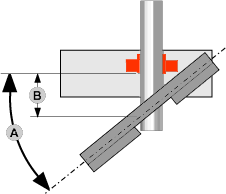
Swivel frame horizontal saw - top view. The blade moves away from the vise as the frame is swivelled (A), increasing the length of unsupported material and the remnant length (B). |
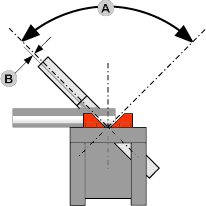
Vertical saw - front view. As the column is tilted (A) the blade remains in the same relationship to the vise jaws. The remnant length remains minimal (B). |
| T-Slots
in the worktable makes for easy fixturing. On the Marvel vertical
tilt frame saws T-Slots allow for locating work holding devices of various
styles to secure materials which are not easily held or are too large to
fit in the vise jaws. There are no provisions like this on horizontal
saws.
|
